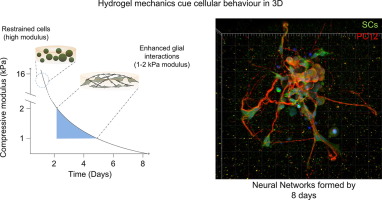当前位置:
X-MOL 学术
›
Acta Biomater.
›
论文详情
Our official English website, www.x-mol.net, welcomes your
feedback! (Note: you will need to create a separate account there.)
Tissue engineered hydrogels supporting 3D neural networks.
Acta Biomaterialia ( IF 9.4 ) Pub Date : 2018-11-27 , DOI: 10.1016/j.actbio.2018.11.044 Ulises A Aregueta-Robles 1 , Penny J Martens 1 , Laura A Poole-Warren 1 , Rylie A Green 2
Acta Biomaterialia ( IF 9.4 ) Pub Date : 2018-11-27 , DOI: 10.1016/j.actbio.2018.11.044 Ulises A Aregueta-Robles 1 , Penny J Martens 1 , Laura A Poole-Warren 1 , Rylie A Green 2
Affiliation

|
Promoting nerve regeneration requires engineering cellular carriers to physically and biochemically support neuronal growth into a long lasting functional tissue. This study systematically evaluated the capacity of a biosynthetic poly(vinyl alcohol) (PVA) hydrogel to support growth and differentiation of co-encapsulated neurons and glia. A significant challenge is to understand the role of the dynamic degradable hydrogel mechanical properties on expression of relevant cellular morphologies and function. It was hypothesised that a carrier with mechanical properties akin to neural tissue will provide glia with conditions to thrive, and that glia in turn will support neuronal survival and development. PVA co-polymerised with biological macromolecules sericin and gelatin (PVA-SG) and with tailored nerve tissue-like mechanical properties were used to encapsulate Schwann cells (SCs) alone and subsequently a co-culture of SCs and neural-like PC12s. SCs were encapsulated within two PVA-SG gel variants with initial compressive moduli of 16 kPa and 2 kPa, spanning a range of reported mechanical properties for neural tissues. Both hydrogels were shown to support cell viability and expression of extracellular matrix proteins, however, SCs grown within the PVA-SG with a higher initial modulus were observed to present with greater physiologically relevant morphologies and increased expression of extracellular matrix proteins. The higher modulus PVA-SG was subsequently shown to support development of neuronal networks when SCs were co-encapsulated with PC12s. The lower modulus hydrogel was unable to support effective development of neural networks. This study demonstrates the critical link between hydrogel properties and glial cell phenotype on development of functional neural tissues. STATEMENT OF SIGNIFICANCE: Hydrogels as platforms for tissue regeneration must provide encapsulated cellular progenitors with physical and biochemical cues for initial survival and to support ongoing tissue formation as the artificial network degrades. While most research focuses on tailoring scaffold properties to suit neurons, this work aims to support glia SCs as the key cellular component that physically and biochemically supports the neuronal network. The challenge is to modify hydrogel properties to support growth and development of multiple cell types into a neuronal network. Given SCs ability to respond to substrate mechanical properties, the significance of this work lies in understanding the relationship between dynamic hydrogel mechanical properties and glia SCs development as the element that enables formation of mature, differentiated neural networks.
中文翻译:

支持3D神经网络的组织工程水凝胶。
促进神经再生需要工程化细胞载体以物理和生物化学方式支持神经元生长成持久的功能组织。这项研究系统地评估了生物合成的聚乙烯醇(PVA)水凝胶支持共包封的神经元和神经胶质细胞生长和分化的能力。一个重大挑战是要了解动态可降解水凝胶力学性能对相关细胞形态和功能表达的作用。假设具有类似于神经组织的机械特性的载体将为神经胶质提供生长的条件,而神经胶质又将支持神经元的存活和发育。将PVA与生物大分子丝胶和明胶(PVA-SG)共聚合并具有定制的神经组织样机械性能,将其单独包裹雪旺细胞(SCs),然后将SCs和神经样PC12共培养。SCs被封装在两个PVA-SG凝胶变体中,其初始压缩模量分别为16 kPa和2 kPa,涵盖了神经组织的一系列力学性能。两种水凝胶均显示支持细胞活力和细胞外基质蛋白的表达,但是,观察到在PVA-SG内生长的SC具有较高的初始模量,并具有更大的生理相关形态和细胞外基质蛋白的表达。随后显示出,当SC与PC12共封装时,较高模量的PVA-SG可支持神经网络的发育。较低模量的水凝胶无法支持神经网络的有效发展。这项研究证明了水凝胶特性与神经胶质细胞表型之间的关键联系对功能性神经组织的发育。意义声明:水凝胶作为组织再生的平台,必须为封装的细胞祖细胞提供物理和生化线索,以保证其最初的存活,并随着人工网络的退化而支持正在进行的组织形成。虽然大多数研究都集中在调整支架的特性以适应神经元,但这项工作旨在支持神经胶质细胞作为物理和生化支持神经元网络的关键细胞成分。面临的挑战是修改水凝胶特性以支持多种细胞类型向神经元网络的生长和发育。鉴于SC能够响应基质的机械性能,这项工作的意义在于理解动态水凝胶机械性能与神经胶质SC的发展之间的关系,因为它是能够形成成熟的,分化的神经网络的要素。
更新日期:2019-08-23
中文翻译:

支持3D神经网络的组织工程水凝胶。
促进神经再生需要工程化细胞载体以物理和生物化学方式支持神经元生长成持久的功能组织。这项研究系统地评估了生物合成的聚乙烯醇(PVA)水凝胶支持共包封的神经元和神经胶质细胞生长和分化的能力。一个重大挑战是要了解动态可降解水凝胶力学性能对相关细胞形态和功能表达的作用。假设具有类似于神经组织的机械特性的载体将为神经胶质提供生长的条件,而神经胶质又将支持神经元的存活和发育。将PVA与生物大分子丝胶和明胶(PVA-SG)共聚合并具有定制的神经组织样机械性能,将其单独包裹雪旺细胞(SCs),然后将SCs和神经样PC12共培养。SCs被封装在两个PVA-SG凝胶变体中,其初始压缩模量分别为16 kPa和2 kPa,涵盖了神经组织的一系列力学性能。两种水凝胶均显示支持细胞活力和细胞外基质蛋白的表达,但是,观察到在PVA-SG内生长的SC具有较高的初始模量,并具有更大的生理相关形态和细胞外基质蛋白的表达。随后显示出,当SC与PC12共封装时,较高模量的PVA-SG可支持神经网络的发育。较低模量的水凝胶无法支持神经网络的有效发展。这项研究证明了水凝胶特性与神经胶质细胞表型之间的关键联系对功能性神经组织的发育。意义声明:水凝胶作为组织再生的平台,必须为封装的细胞祖细胞提供物理和生化线索,以保证其最初的存活,并随着人工网络的退化而支持正在进行的组织形成。虽然大多数研究都集中在调整支架的特性以适应神经元,但这项工作旨在支持神经胶质细胞作为物理和生化支持神经元网络的关键细胞成分。面临的挑战是修改水凝胶特性以支持多种细胞类型向神经元网络的生长和发育。鉴于SC能够响应基质的机械性能,这项工作的意义在于理解动态水凝胶机械性能与神经胶质SC的发展之间的关系,因为它是能够形成成熟的,分化的神经网络的要素。











































 京公网安备 11010802027423号
京公网安备 11010802027423号